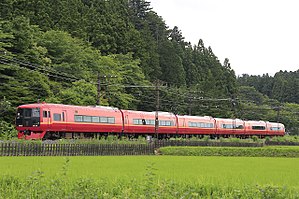TheNikkō(Ánh nắng)andSpacia Nikkō(スペーシア ánh nắng)arelimited expresstrain services in Japan operated jointly by theEast Japan Railway Company(JR East) andTobu RailwaybetweenShinjukuin Tokyo andTōbu NikkōinTochigi Prefecture.[1]
 A 253-1000 series EMU on aNikkoservice in June 2017 | |
| Overview | |
|---|---|
| Service type | Limited express |
| Locale | Yamanote Freight Line,Tohoku Main Line,Tobu Nikko Line |
| First service | 1956 (Semi express) 1963 (Express) 2006 (Limited express) |
| Current operator(s) | JR East/Tobu Railway |
| Former operator(s) | JNR |
| Route | |
| Termini | Shinjuku Tōbu Nikkō |
| Technical | |
| Rolling stock | 253-1000 series,Tobu 100 seriesEMUs |
| Track gauge | 1,067 mm(3 ft 6 in) |
| Electrification | 1,500 V DC overhead |
| Operating speed | 120 km/h (75 mph)[1] |
Station stops
editNikkōandSpacia Nikkōservices stop at the following stations.[2]
Rolling stock
editSince 4 June 2011, services are formed of refurbished253-1000 series6-car EMU sets.[3]Tobu 100 seriesSpaciaEMUs may also be substituted on these services, in which case they are namedSpacia Nikkō.[1]Prior to 4 June 2011, JR East services were formed of a dedicated 6-car485 seriesEMU set, which was occasionally substituted by a reserve189 seriesset nicknamedAyano(Màu dã).[1]
Past
edit- KiHa 44800 DMUs (October 1956–September 1959)
- 157 seriesEMUs (September 1959–March 1963)
- 165 seriesEMUs (March 1963–October 1982)
- 485 series/189 seriesEMUs (March 2006–June 2011)
-
A Tobu 100 seriesSpaciaEMU in special gold "Nikko Moude" livery in April 2017
-
A JR East 485 series EMU at Omiya Station on aNikkoservice in March 2011
-
The 189 seriesAyanoset used as a spare forNikkoservices, September 2010
History
editSemi-expressNikkō
editTheNikkōservice began as a semi-express service betweenUenoin Tokyo andNikkōfrom 10 October 1956 using KiHa 44800 series DMUs. Following electrification of the line, new157 seriesEMUs were introduced from 22 September 1959. These ran as 6-car sets, lengthened to 8 cars during busy seasons. The 157 series sets were subsequently fitted with air-conditioning and transferred toTokaido Main Lineduties.[4]
Semi-expressShōnan Nikkō
editFrom 1 April 1961, the seasonalIdeyusemi express services that operated between Tokyo andItōwere extended to form new seasonalShōnan Nikkōservices operating between Itō and Nikkō. These were formed of 6-car 157 series sets based at Tamachi Depot in Tokyo.[5]The 157 series EMUs on these services were replaced by 165 series from 25 March 1963.[5]From the October 1968 timetable revision, the services were cut back to a single Nikkō to Itō working, and from 1 October 1970, this service was discontinued, replaced by theIzu56 working from Tokyo to Itō.[6]
- 2502TShōnan NikkōItō 07:46 → Nikkō 11:59
- 2501TShōnan NikkōNikkō 13:45 → Itō 17:50
The trains were formed as shown below.[5]
| Car | 1 | 2 | 3 | 4 | 5 | 6 |
|---|---|---|---|---|---|---|
| Type | KuMoHa 157 | MoHa 156 | SaRo 157 | SaHa 157 | MoHa 156 | KuMoHa 157 |
ExpressNikkō
editFrom 25 March 1963, the service was upgraded to "Express" status with the introduction of new165 seriesEMUs, running as 7-car formations with the inclusion of a "SaRo" Green (first class) car.[4]This service operated until 14 October 1982, made redundant by the opening of theTohoku Shinkansen.[7]
Limited expressNikkō
editThe name was subsequently revived from 18 March 2006 as a limited express service operated jointly by JR East and Tobu betweenShinjukuandTōbu Nikkō,utilizing a newly constructed link between the two railways' tracks atKurihashi Station,where trains stop briefly for a crew change.[1]
From the start of the revised timetable on 16 March 2013,Nikkōservices also stop atUrawa Station.
See also
edit- Kinugawa- a similar service between Shinjuku and Kinugawa-Onsen, also jointly operated by JR East and Tobu
References
edit- ^abcdeJR Shinkansen & đặc cấp đoàn tàu ファイル[JR Shinkansen & Limited Express Train File]. Japan: Kōtsū Shimbun. 2008. p. 76.ISBN978-4-330-00608-6.
- ^JR Timetable, March 2013 issue, p. 102
- ^485 hệ が "Ánh nắng" ・ "きぬがわ" vận dụng を chung える[End of 485 series operations onNikkoandKinugawaservices].Japan Railfan Magazine Online(in Japanese). Japan: Koyusha Co., Ltd. 4 June 2011.Retrieved4 June2011.
- ^abKubo, Satoshi (September 2011).Ánh nắng tham nghệ へ の tạp nói -1[The mountain route to Nikko].Japan Railfan Magazine.Vol. 51, no. 605. Japan: Kōyūsha Co., Ltd. pp. 120–125.
- ^abcMiyake, Toshihiko (December 2011).Y đậu へ の loại ưu đoàn tàu の あゆみ[History of premier trains to Izu].Tetsudō Daiya Jōhō Magazine.Vol. 40, no. 332. Japan: Kotsu Shimbun. pp. 24–31.
- ^Teramoto, Mitsuteru (July 2001).Quốc thiết ・JR đoàn tàu danh đại từ điển[JNR & JR Train Name Encyclopedia]. Tokyo, Japan: Chuoshoin Publishing Co., Ltd.ISBN4-88732-093-0.
- ^Đoàn tàu danh giam 1995[Train Name Directory 1995]. Japan: Railway Journal. August 1995. p. 128.
External links
edit- JR East 485 seriesNikkō/Kinugawa(in Japanese)